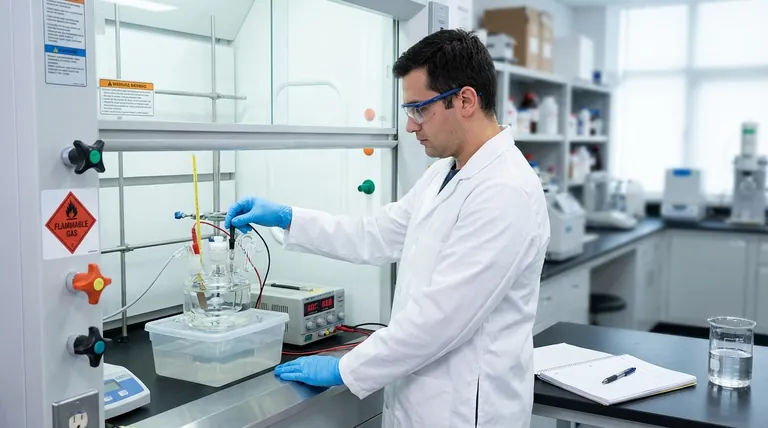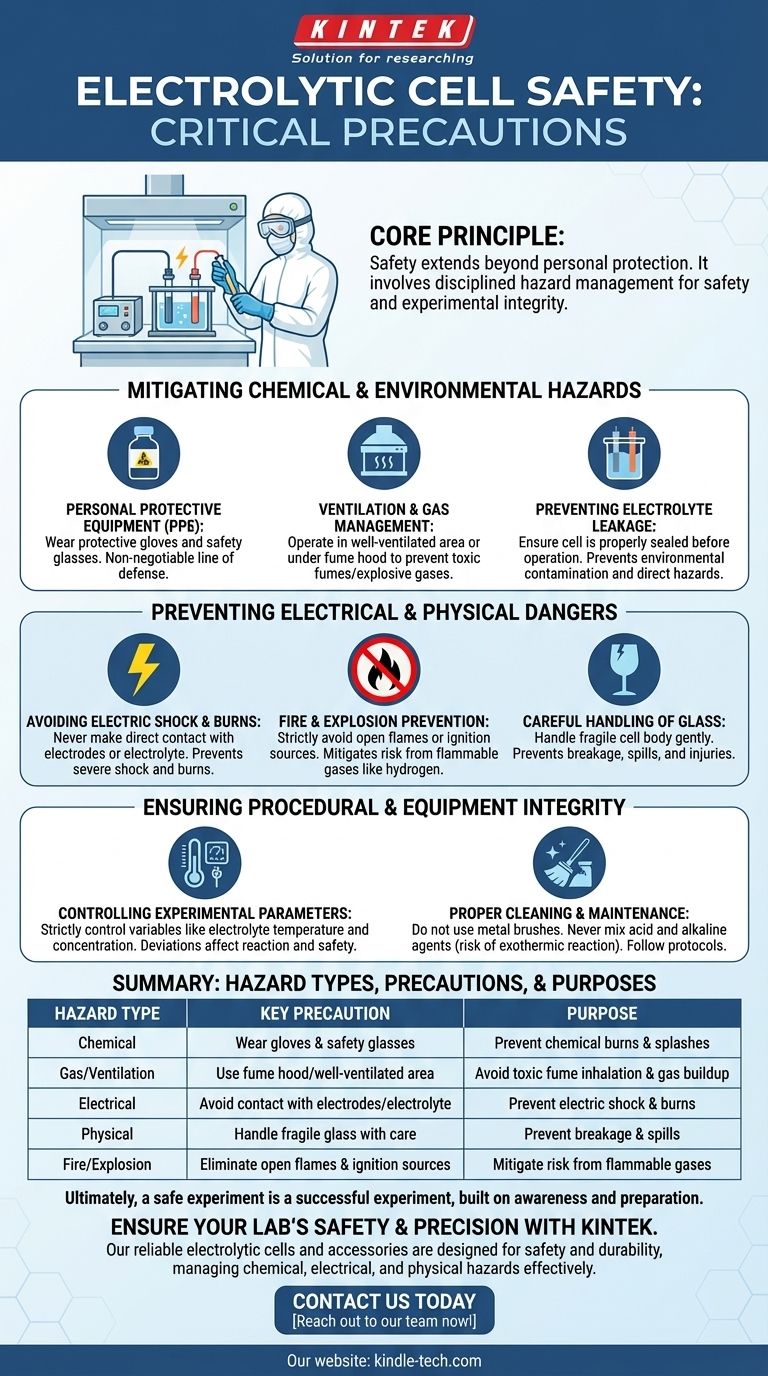When operating an electrolytic cell, the most critical safety precautions involve wearing appropriate personal protective equipment (PPE) like gloves and glasses, ensuring the workspace is well-ventilated, and avoiding direct physical contact with electrodes or the electrolyte. You must also handle the fragile glass components with care and be mindful of electrical and fire hazards.
The core principle of electrolytic cell safety extends beyond personal protection. It involves a disciplined approach to managing chemical, electrical, and physical hazards to ensure not only your safety but also the integrity and accuracy of your experimental results.

Mitigating Chemical and Environmental Hazards
The primary chemical risks stem from the electrolyte itself and the gases produced during the reaction. A systematic approach to containing these materials is essential.
Personal Protective Equipment (PPE)
When handling any corrosive electrolytes, wearing protective gloves and safety glasses is non-negotiable. This simple step is the first line of defense against chemical burns and splashes.
Ventilation and Gas Management
Electrolysis can produce harmful or flammable gases and generate high temperatures. Operating the cell in a well-ventilated area or under a fume hood is crucial to prevent the inhalation of toxic fumes and the buildup of explosive gases.
Preventing Electrolyte Leakage
Ensure the cell is properly sealed before operation. A leak can not only compromise your experimental data but also cause environmental contamination and create a direct chemical hazard for the operator.
Preventing Electrical and Physical Dangers
Beyond the chemicals, the cell itself presents distinct physical and electrical risks that require careful management.
Avoiding Electric Shock and Burns
Never make direct contact with the electrodes or the electrolyte during operation. This is the most direct way to prevent severe electric shock or chemical burns.
Fire and Explosion Prevention
The production of flammable gases, such as hydrogen, introduces a significant risk. Strictly avoid using open flames or other ignition sources near the electrolytic cell to prevent a potential fire or explosion.
Careful Handling of Glass Components
Most electrolytic cells are constructed from glass, making them inherently fragile. Always handle the cell body gently and carefully to prevent breakage, which could lead to spills, injuries, and the complete loss of your experiment.
Ensuring Procedural and Equipment Integrity
Safe operation is not just about avoiding immediate harm; it is also about maintaining the equipment and the validity of your work. Mistakes in procedure can create hazards and ruin your results.
Controlling Experimental Parameters
Strictly control variables like electrolyte temperature and concentration. Deviations can negatively affect the reaction, damage the cell, and produce unexpected, potentially hazardous byproducts. If using a water bath, regularly verify that its thermometer and controller are accurate.
Proper Cleaning and Maintenance
When cleaning the cell, do not use metal brushes that can scratch the delicate surfaces. It is also forbidden to mix acid and alkaline cleaning agents, as this can trigger a dangerous exothermic reaction. Following proper cleaning protocols preserves the equipment for future use.
Making the Right Choice for Your Goal
Your specific experimental conditions dictate which precautions are most critical.
- If your primary focus is working with corrosive or toxic materials: Your top priority is containment and personal protection, making the use of a fume hood, gloves, and safety glasses absolutely essential.
- If your primary focus is a reaction that produces flammable gases: Your main concern is preventing ignition, so you must eliminate all potential flame or spark sources from the immediate area.
- If your primary focus is achieving high-precision results: You must meticulously control environmental parameters like temperature and prevent any leaks or contamination, as these directly impact data integrity.
Ultimately, a safe experiment is a successful experiment, built on a foundation of awareness and careful preparation.
Summary Table:
| Hazard Type | Key Precaution | Purpose |
|---|---|---|
| Chemical | Wear gloves and safety glasses | Prevent chemical burns and splashes |
| Gas/Ventilation | Use a fume hood or well-ventilated area | Avoid toxic fume inhalation and gas buildup |
| Electrical | Avoid contact with electrodes/electrolyte | Prevent electric shock and burns |
| Physical | Handle fragile glass components with care | Prevent breakage and spills |
| Fire/Explosion | Eliminate open flames and ignition sources | Mitigate risk from flammable gases like hydrogen |
Ensure your lab's safety and precision with KINTEK's reliable electrolytic cells and accessories. Proper equipment is the foundation of secure and accurate experiments. Our products are designed with safety and durability in mind, helping you manage chemical, electrical, and physical hazards effectively. Contact us today to find the right solutions for your laboratory needs and let our experts support your research with quality equipment you can trust. Reach out to our team now!
Visual Guide

Related Products
- Double Layer Five-Port Water Bath Electrolytic Electrochemical Cell
- Electrolytic Electrochemical Cell with Five-Port
- Quartz Electrolytic Electrochemical Cell for Electrochemical Experiments
- Double-Layer Water Bath Electrolytic Electrochemical Cell
- H Type Electrolytic Cell Triple Electrochemical Cell
People Also Ask
- How should a double-layer water-bath electrolytic cell be operated? A Step-by-Step Guide for Reliable Results
- What regular inspection and maintenance activities are required for the electrolytic cell? Ensure Reliable Results & Extend Equipment Life
- When is chemical cleaning necessary for an electrolytic cell, and how should it be performed? A Guide to Removing Stubborn Deposits
- How should the electrolytic cell be connected to external equipment during an experiment? A Step-by-Step Guide
- What is the applicable temperature range for the electrolytic cell and how is the temperature controlled? Achieve Precise Electrochemical Results



















